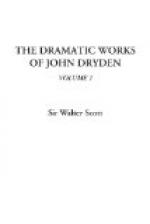The “Royal Martyr” was acted in 1668-9, and printed in 1670. It is, in every respect, a proper heroic tragedy, and had a large share of the applause with which those pieces were then received. It abounds in bombast, but is not deficient in specimens of the sublime and of the tender. The preface is distinguished by that tone of superiority, which Dryden often assumed over the critics of the time. Their general observations he cut short, by observing, that those who make them produce nothing of their own, or only what is more ridiculous than any thing they reprehend. Special objections are refuted, by an appeal to classical authority. Thus the couplet,
“And he, who servilely creeps after
sense,
Is safe, but ne’er will reach an
excellence,”
is justified from the “serpit humi tutus” of Horace; and, by a still more forced derivation, the line,
“And follow fate which does too fast pursue,”
is said to be borrowed from Virgil,
“Eludit gyro interior sequiturque sequentem.”
And he concludes by exulting, that, though he might have written nonsense, none of his critics had been so happy as to discover it. These indications of superiority, being thought to savour of vanity, had their share in exciting the storm of malevolent criticism, of which Dryden afterwards so heavily complained. “Tyrannic Love” is dedicated to the Duke of Monmouth; but it would seem the compliment was principally designed to his duchess. The Duke, whom Dryden was afterwards to celebrate in very different strains, is however compared to an Achilles, or Rinaldo, who wanted only a Homer, or Tasso, to give him the fame due to him.




